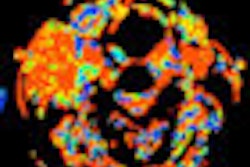A new radiation therapy technique has been proved effective for treating patients with head and neck cancers who have low hemoglobin levels, according to research presented at the European Society for Radiotherapy and Oncology (ESTRO) annual meeting being held this week in Barcelona, Spain.
Patients with low hemoglobin levels tend not to respond well to radiotherapy. As a result, both local control and disease-free survival may be compromised. Researchers from the Netherlands have discovered that the use of accelerated radiotherapy with carbogen and nicotinamide (ARCON) may help such patients.
The treatment combines the water-soluble vitamin nicotinamide and carbogen, a mixture of carbon dioxide and oxygen, with accelerated radiotherapy. When carbogen is inhaled, the increased level of carbon dioxide causes the brain to react to potential suffocation, because it interprets the increase in carbon dioxide in the blood as a decrease in oxygen level. The body compensates by reducing hypoxia, a lack of oxygen in bodily tissues. The addition of nicotinamide also reduces hypoxia by increasing blood flow.
Accelerated radiotherapy to counteract tumor cell repopulation during radiotherapy, combined with carbogen and nicotinamide administered immediately before irradiation to increase oxygen levels, ensures that adaptive mechanisms cannot erode the effect of this treatment, Dr. Hans Kaanders, professor of translation radiation oncology at Radboud University Nijmegen Medical Center, told ESTRO attendees on Thursday. He said that the ARCON therapy regime is the first to show a positive effect in patients with low hemoglobin levels.
Kaanders reported the outcomes of a 345-patient randomized clinical trial in which 174 patients with squamous cell laryngeal cancer received only accelerated radiotherapy of two fractions per day during the last week of treatment. The remaining 171 patients had ARCON therapy.
Patients who had normal hemoglobin levels before conventional radiotherapy had significantly better outcomes than those with low hemoglobin levels. They had better control of the cancer at its primary site (76% compared to 56%), disease-free survival (72% compared to 48%), and metastasis-free survival (90% compared to 70%).
"However, when we looked at the ARCON group, in cases where the patients had low [hemoglobin] levels before treatment, we found that ARCON improved control of the cancer at its primary site, and improved disease-free and metastasis-free survival, so that the differences between them and patients with normal [hemoglobin] levels were no longer significant," said Dr. Geert Janssens, also from Radboud University Nijmegen.
For example, when the low-hemoglobin ARCON patients were compared with the normal-hemoglobin radiotherapy group, the difference in local control was only 1% (81% versus 82%, respectively), the group noted.



















